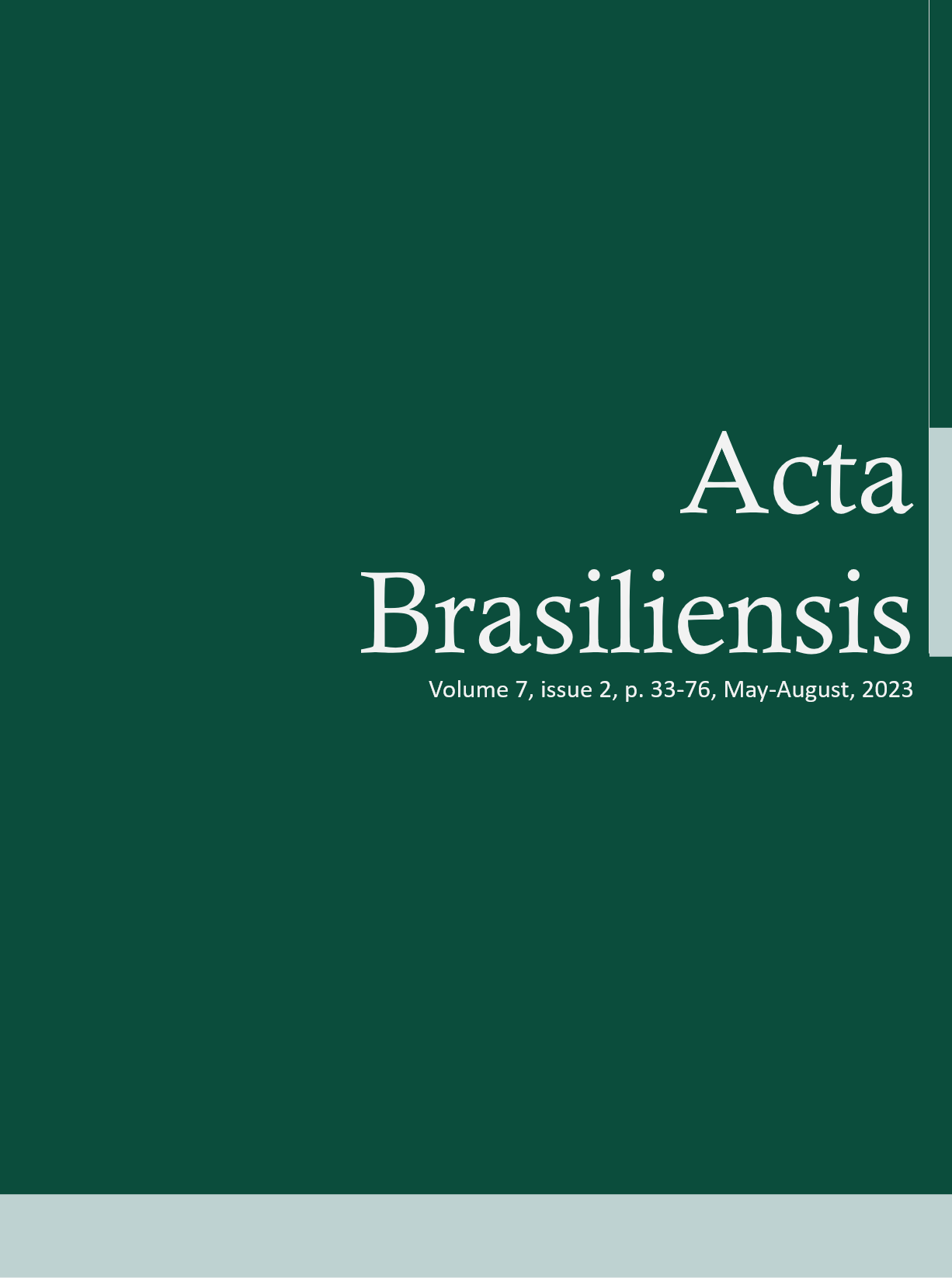O etileno afeta a qualidade fisiológica e a longevidade dos pimentos ornamentais em vaso
DOI:
https://doi.org/10.22571/2526-4338647Palavras-chave:
abscisão, Capsicum spp., longevidade.Resumo
O etileno desencadeia diversas respostas deletérias em plantas ornamentais. Esta investigação teve como objetivo avaliar as respostas do etileno na pós-produção de cultivares de pimenta ornamental em vasos. As plantas das cultivares 'Espaguetinho', 'Etna', 'Peppa' e 'Karneval' foram cultivadas em vasos e ao atingirem a fase de comercialização, ou seja, 50% das plantas com pelo menos 30% dos frutos totalmente maduros, foram submetidas aos tratamentos: controle externo, controle interno e exposição a 10 µL L-1 de etileno durante 48 horas. 'Etna' exibiu resposta intermediária à exposição a 10 µL L-1 de etileno por 48 horas. 'Espaguetinho', 'Peppa' e 'Karneval' foram classificados como altamente sensíveis ao etileno, com descarte no primeiro dia de vida útil. As folhas de todas as cultivares mostraram maior resposta ao etileno do que os frutos. A exposição a 10 µL L-1 de etileno por 48 horas afetou a qualidade e a longevidade das cultivares de pimenta avaliadas, reduzindo drasticamente a vida de prateleira. Este estudo permite, portanto, novas investigações de forma a reduzir as respostas ao etileno, prolongando a vida útil na fase de pós-produção das cultivares de pimenta.
Downloads
Referências
Araújo, F.F., Freire, A.I., Guimarães, M.E.S., Lima, P.C.C., Finger, F.L. (2019). Influence of 1-methylcyclopropene on the longevity of potted ornamental peppers. Revista Brasileira de Ciências Agrárias 14 (1): 1-7. doi: 10.5039/agraria.v14i1a5599.
Blankenship, S.M., Dole, J.M. (2003). 1-Methylcyclopropene: a review. Postharvest Biology and Technology 28 (1): 1-25. doi: 10.1016/S0925-5214(02)00246-6.
Cavatte, R.P.Q., Lima, J.S., Silva, T.P., Cavette, P.C., Finger, F.L. (2013). Influence of temperature and 1-Methylcyclopropene on post-production display life of ornamental pepper (Capsicum annuum L.). Acta Horticulturae 1002: 359-364. doi: 10.17660/ActaHortic.2013.1002.48.
Costa, G.D.N., Silva, B.M.P., Lopes, Â.C.D.A., Carvalho, L.C.B., Gomes, R.L.F. (2019). Selection of pepper accessions with ornamental potential. Caatinga 32 (2): 566-574. doi: 10.1590/1983-21252019v32n230rc.
Finger, F.L., Silva, T.P., Segatto, F.B., Barbosa, J.G. (2015). Inhibition of ethylene response by 1-methylcyclopropene in potted ornamental pepper. Ciência Rural 45 (6): 964-969. doi: 10.1590/0103-8478cr20131386.
Hornero-Méndez, D., Gómez-Ladrón, G.R., Mínguez-Mosquera, M. I. (2000). Carotenoid biosynthesis changes in five red pepper (Capsicum annuum L.) cultivars during ripening. Cultivar selection for breeding. Journal of Agricultural and Food Chemistry 48 (9): 3857-3864. doi: 10.1021/jf991020r.
Iqbal, N., Khan, N.A. , Ferrante, A., Trivellini, A., Francini, A. (2017). Ethylene role in plant growth, development and senescence: interaction with other phytohormones. Frontiers in Plant Science 8 (475): 1-18. doi: 10.3389/fpls.2017.00475.
ISLA. (2018). Pimenta Ornamental. ISLA Sementes. Porto Alegre. Disponível em: <http://www.isla.com.br>. Acesso em: 9 dec. 2020.
Junqueira, A.H., Peets, M.S. (2002). Os pólos de produção de flores e plantas ornamentais do Brasil: uma análise do potencial exportador. Revista Brasileira de Horticultura Ornamental 18 (1/2): 25-47 (in Portuguese). doi: 10.14295/rbho.v8i1.309.
Khan, A.N. (2006). Ethylene action in plants. Netherlands; Springer, 205p.
Lima, P.C.C., Ribeiro, W.S., Oliveira, M.M.T., Costa, L.C., Finger, F.L. (2017). Ethylene, 1-methylcyclopropene and silver thiosulfate on the post-production of ornamental pepper. Ciência Rural 47 (2): p.e20151611. doi: 10.1590/0103-8478cr20151611.
Mapeli, A.M., Oliveira, L.S, Megguer, C.A., Barbosa, J.G., Barros, R.S., Finger, F.L. (2009). Characterisation of respiration, ethylene production, and carbohydrate contents during flower opening in Epidendrum ibaguense. The Journal of Horticultural Science and Biotechnology 84 (6): 609-612. doi: 10.1080/14620316.2009.11512574.
Moraes, P.J., Finger, F.L., Barbosa, J.G., Cecon, P.R. (2007). Longevidade pós-colheita da orquídea Epidendrum ibaguense Kunth. Revista Brasileira de Horticultura Ornamental 13 (1): 31-37 (in Portuguese). doi: 10.14295/rbho.v13i1.203.
Nazar, R., Khan, M.I.R, Iqbal, N., Masood, A., khan, N.A. (2014). Involvement of ethylene in reversal of salt-inhibited photosynthesis by sulfur in mustard. Physiology Plant 152 (2): 331-344. doi: 10.1111/ppl.12173.
Ribeiro, W.S., Carneiro, C.S., França, C.F.M., Pinto, C.F.M., Lima, P.C.C. (2019). Sensitivity of ornamental pepper to ethylene. Horticultura Brasileira 37 (4): 458-463. doi: 10.1590/S0102-053620190415.
Roberts, C.M., Serek, M., Andersen, A.S. (1995). Suplemental Irradiance and STS improve the display life of Dicentra species forced as flowering potted plants. Scientia Horticulturae 62 (1/2): 121-128. doi: 10.1016/0304-4238(95)00774-N.
Segatto, F.B., Finger, F.L., Barbosa, J.G., Rêgo, E.R., Pinto, C.M.F. (2013). Effects of Ethylene on the post-production of potted ornamental peppers (Capsicum annuum L.). Acta Horticulturae 1000 (28): 217-222. doi: 10.17660/ActaHortic.2013.1000.28.
Serek, M., Reid, M.S. (1993). Anti-ethylene treatments for potted Christmas Cactus – efficacy of inhibitors of ethylene action and biosynthesis. HortScience 28 (2): 180-181. doi: 10.21273/HORTSCI.28.12.1180.
Verlinden, S., Boatright, J., Woodson, W.R. (2002). Changes in ethylene responsiveness of senescence-related genes during carnation flower development. Physiologia Plantarum 116 (4): 503-511. doi: 10.1034/j.1399-3054.2002.1160409.x.


